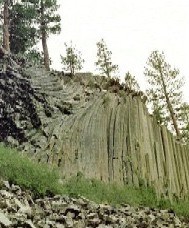
Devils Postpile National Monument is a small but rich environment. Located on the western slope of the Sierra Nevada range between 7,200 and 8,200 feet (2,200 to 2,500 meters), the monument contains an interesting assemblage of flora, fauna and geology.
The flora and fauna at Devils Postpile are typical of the Sierra Nevada. Visitors can see animals such as chipmunks, black bear, eagles, and deer. Plants such as pine and fir trees abound, as well as many wildflowers. Click here to learn more about plants and animals. |
Last updated: March 18, 2020
